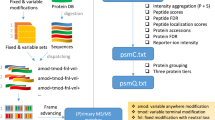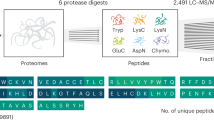Abstract
Two major challenges in proteomics are the large number of proteins and their broad dynamic range in the cell. We exploited the abundance-dependent Michaelis-Menten kinetics of trypsin digestion to selectively digest and deplete abundant proteins with a method we call DigDeAPr. We validated the depletion mechanism with known yeast protein abundances, and we observed greater than threefold improvement in low-abundance human-protein identification and quantitation metrics. This methodology should be broadly applicable to many organisms, proteases and proteomic pipelines.
This is a preview of subscription content, access via your institution
Access options
Subscribe to this journal
Receive 12 print issues and online access
$259.00 per year
only $21.58 per issue
Buy this article
- Purchase on Springer Link
- Instant access to full article PDF
Prices may be subject to local taxes which are calculated during checkout



Similar content being viewed by others
References
Cravatt, B.F., Simon, G.M. & Yates, J.R. III. Nature 450, 991–1000 (2007).
Nilsson, T. et al. Nat. Methods 7, 681–685 (2010).
Washburn, M.P., Wolters, D. & Yates, J.R. III. Nat. Biotechnol. 19, 242–247 (2001).
MacCoss, M.J. et al. Proc. Natl. Acad. Sci. USA 99, 7900–7905 (2002).
Choudhary, G., Wu, S.L., Shieh, P. & Hancock, W.S. J. Proteome Res. 2, 59–67 (2003).
Swaney, D.L., Wenger, C.D. & Coon, J.J. J. Proteome Res. 9, 1323–1329 (2010).
Tran, B.Q. et al. J. Proteome Res. 10, 800–811 (2011).
Manza, L.L., Stamer, S.L., Ham, A.J., Codreanu, S.G. & Liebler, D.C. Proteomics 5, 1742–1745 (2005).
Wu, C.C., MacCoss, M.J., Howell, K.E. & Yates, J.R. III. Nat. Biotechnol. 21, 532–538 (2003).
Blonder, J., Chan, K.C., Issaq, H.J. & Veenstra, T.D. Nat. Protoc. 1, 2784–2790 (2006).
Wu, C. et al. Nat. Methods 9, 822–824 (2012).
Picotti, P., Aebersold, R. & Domon, B. Mol. Cell. Proteomics 6, 1589–1598 (2007).
Liu, H., Sadygov, R.G. & Yates, J.R. III. Anal. Chem. 76, 4193–4201 (2004).
Jmeian, Y. & El Rassi, Z. Electrophoresis 30, 249–261 (2009).
Liebler, D.C. & Ham, A.J. Nat. Methods 6, 785 (2009).
McDonald, W.H. et al. Rapid Commun. Mass Spectrom. 18, 2162–2168 (2004).
Xu, T. et al. Mol. Cell. Proteomics 5, S174 (2006).
Tabb, D.L., McDonald, W.H. & Yates, J.R. III. J. Proteome Res. 1, 21–26 (2002).
Cociorva, D., Tabb, D.L. & Yates, J.R. Curr. Protoc. Bioinformatics 16, 13.4 (2007).
Wong, C.C., Cociorva, D., Venable, J.D., Xu, T. & Yates, J.R. III. J. Am. Soc. Mass Spectrom. 20, 1405–1414 (2009).
Park, S.K., Venable, J.D., Xu, T. & Yates, J.R. III. Nat. Methods 5, 319–322 (2008).
Fonslow, B.R. et al. J. Proteome Res. 10, 3690–3700 (2011).
Acknowledgements
This project was supported by the US National Center for Research Resources (5P41RR011823-17), National Institute of General Medical Sciences (8P41GM103533-17), National Institute of Diabetes and Digestive and Kidney Diseases (R01DK074798), National Heart, Lung, and Blood Institute (RFP-NHLBI-HV-10-5) and National Institute of Mental Health (R01MH067880). We thank J.N. Savas, C.M. Delahunty and J.K. Diedrich for comments on the manuscript.
Author information
Authors and Affiliations
Contributions
B.R.F. designed experiments, performed experiments, analyzed data and wrote the manuscript. B.D.S. prepared HEK cell lysates and provided conceptual advice. K.J.W. prepared yeast lysates. T.X., J.C. and S.K.P. developed software for data analysis. J.R.Y. wrote the manuscript and provided conceptual guidance.
Corresponding author
Ethics declarations
Competing interests
The authors declare no competing financial interests.
Supplementary information
Supplementary Text and Figures
Supplementary Figures 1–8 and Supplementary Notes 1–6 (PDF 726 kb)
Supplementary Data
Protein and peptide raw data and comparisons from yeast and HEK-cell control and DigDeAPr analyses. (XLSX 49758 kb)
Rights and permissions
About this article
Cite this article
Fonslow, B., Stein, B., Webb, K. et al. Digestion and depletion of abundant proteins improves proteomic coverage. Nat Methods 10, 54–56 (2013). https://doi.org/10.1038/nmeth.2250
Received:
Accepted:
Published:
Issue Date:
DOI: https://doi.org/10.1038/nmeth.2250
This article is cited by
-
The influence of folic acid-induced acute kidney injury on cardiac function and redox status in rats
Naunyn-Schmiedeberg's Archives of Pharmacology (2020)
-
Attenuated palmitoylation of serotonin receptor 5-HT1A affects receptor function and contributes to depression-like behaviors
Nature Communications (2019)
-
The contribution of Alu exons to the human proteome
Genome Biology (2016)
-
Cardiovascular proteomics in the era of big data: experimental and computational advances
Clinical Proteomics (2016)
-
Enrichment of extracellular vesicles from tissues of the central nervous system by PROSPR
Molecular Neurodegeneration (2016)



